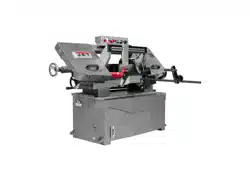Loading ...
Loading ...
Loading ...

11
7. Remove blade from both wheels and out of
each blade guide.
8. Make sure teeth of new blade are pointing in
proper direction of travel. Work blade all the
way up into blade guide bearings and guide
blocks with back of blade against rear support
bearing. See sect. 7.5 for further details.
9. Position blade through upper slot. Put light
tension on blade and work it onto both wheels.
Make sure back of blade is against shoulder
of both wheels.
10. When you are sure that back of blade is against
shoulder of both wheels and properly inserted
into guides, finish putting tension on blade. See
sect. 7.2.
11. Adjust guide bearings (sect. 7.5).
12. Connect power and jog the on/off button to be
sure blade is in place and tracking properly. If
blade is not tracking properly refer to sect. 7.3.
13. Close all covers and guards and tighten
securely. Reposition wire brush.
7.2 Blade tension
Blade tension has been preset by the manufacturer;
if further adjustment is required, or after installing a
new blade, turn handwheel (C, Figure 7-1)
clockwise to approximately 25,000 pounds, as
indicated on adjacent tension scale.
If band saw will remain idle for an extended period,
back off blade tension to reduce unnecessary wear
on wheels and components.
7.3 Blade tracking
Tools required: 17mm and 24mm wrenches
Blade tracking requires wheel
covers open and blade moving. Use extreme
caution and keep hands away from blade and
wheel areas. Failure to comply may result in
serious injury.
Blade tracking has been initially set by the
manufacturer. Adjustment is rarely required when
blade is correctly welded and used properly.
Tracking is set properly when back of blade lightly
touches shoulder of wheels. Note: Over-tracking
(allowing blade back to rub hard against wheel
shoulder) may damage blade wheels and blade.
1. Disconnect machine from power source.
2. Raise bow enough to deactivate shut-off
sensor.
3. Loosen four knobs and open wheel covers.
Remove upper gap cover (A, Figure 7-1) and
lower blade guard (B).
4. Back off left and right bearing guide assemblies.
5. NOTE: Maintain proper tension at all times
using blade tensioning mechanism.
6. Loosen center locking screws (D
1
, Figure 8-3)
in all three hex adjustment screws (D
2
,D
3
).
Figure 7-2
While performing the
following, keep blade from rubbing
excessively on wheel shoulder, which can
damage wheel and/or blade.
7. Start saw blade, and slowly turn left hex
adjustment screw (D
3
, Figure 7-2) to tilt idler
wheel. Do not turn either of the other two
adustment screws (D
2
).
NOTE: Turning screw inward causes blade to
move toward wheel shoulder. Turning screw
outward causes blade to move away from
shoulder.
8. Turn screw (D
3
) so blade begins to move away
from wheel shoulder. Then immediately turn
screw in opposite direction so that blade halts
its migration, then moves slowly back toward
shoulder. Stop when blade makes very light
contact with shoulder.
9. Turn off saw blade.
10. Hold hex adjustment screws (D
2
,D
3
) with a
wrench and tighten center locking screws (D
1
).
Make sure hex adjustment screws do not move
while tightening the center screws.
11. Adjust left and right bearing guide assemblies.
Refer to sect. 7.5.
12. Install upper gap cover (A, Figure 7-1) and
lower blade guard (B). Close blade wheel
covers and secure with knobs.
7.4 Blade guide bracket adjustment
The bracket(s) (E, Figure 7-1) should be set as close
to workpiece as possible without causing
obstruction. Loosen front knobs (HBS-1018) or rear
handle (HBS-916) and slide the bracket, then
tighten in position.
Loading ...
Loading ...
Loading ...
